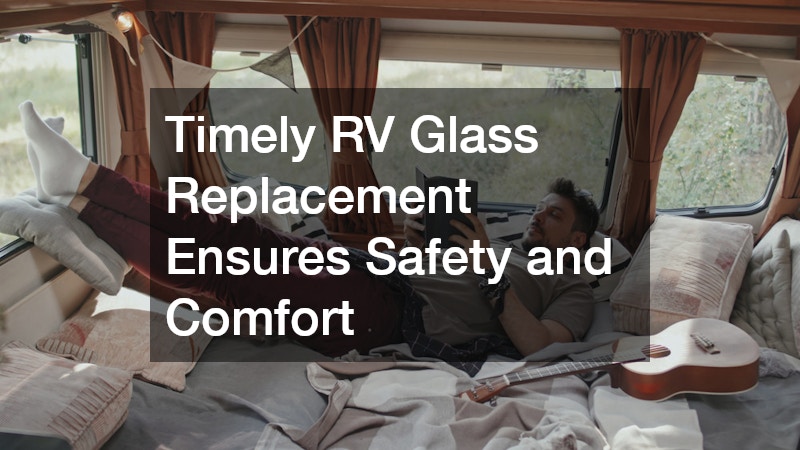
In this article, we will explore the ins and outs of RV glass replacement to ensure your road-ready rigs are safe and sound for your next adventure. Whether you’re dealing with chips, cracks, or full-on breakage, understanding the replacement process is key to maintaining the integrity and comfort of your RV.
How Do I Know if My RV Needs Glass Replacement?
Identifying Signs of Damage
Examining your RV windows regularly is essential for spotting chips, cracks, and other forms of damage that may necessitate a replacement. Visual inspections should be conducted frequently to identify any flaws that compromise the structural integrity of the glass.
Beyond visible damage, pay attention to drafts or moisture build-up inside the vehicle, which could suggest compromised seals. These signs might not only lead to discomfort but also indicate larger underlying problems with your windows.
If left unchecked, minor chips can quickly develop into larger cracks, exacerbated by temperature changes or vibrations from traveling. Proactive identification of such issues can save you from future inconveniences on your journeys.
Assessing the Severity of Damage
Once damage is identified, the next step is assessing whether it’s merely cosmetic or poses a safety hazard requiring urgent attention. Small chips can generally be repaired, but larger cracks often necessitate full-window replacement to ensure passenger safety.
Assessing the size, depth, and location of the damage will help determine its impact on visibility and structural integrity. For example, a crack interfering with the driver’s field of vision is a significant safety concern and needs immediate fixing.
Consulting with a professional can provide clarity on the extent of damage and the recommended course of action. Expertise in the field can alleviate uncertainties and ensure you opt for the best repair or replacement solution.
What Are My Options for Local RV Glass Replacement?
Choosing Between OEM and Aftermarket Glass
Understanding the differences between Original Equipment Manufacturer (OEM) glass and aftermarket options is crucial in making an informed decision. OEM glass is made by the same manufacturer as the original parts, ensuring a perfect fit and potentially higher quality.
An important fact to consider is that aftermarket glass is often cheaper and more readily available, but the fit and quality might not match OEM standards. Despite this, many find aftermarket options satisfactory for their needs and appreciate the cost savings.
Ultimately, the choice between OEM and aftermarket glass will depend on your budget, availability, and personal preference for matching original specifications. Knowledge of these factors can significantly influence your overall satisfaction with the replacement process.
Finding a Reliable Local Glass Replacement Service
Choosing a trustworthy local RV glass replacement provider is imperative for effective RV glass replacement, and several factors can aid in making the right choice. Start by looking for specialized services with extensive experience in RV glass repairs.
Reputable providers usually come with positive reviews and testimonials from previous customers. Online research or recommendations from fellow RV enthusiasts can also lead you towards a credible service provider.
Before committing, confirm that the service provider offers warranties on both labor and materials. This form of guarantee is pivotal in ensuring that you’re protected against any future defects or service inadequacies.
What is the Process for Replacing RV Glass?
Step-by-Step Glass Replacement Process
Understanding the step-by-step process involved in replacing damaged RV glass is crucial for setting expectations and preparing for repairs. The initial phase involves assessing the damage and making recommendations based on the severity and location.
Once the plan is confirmed, the old or damaged glass is carefully removed, ensuring no harm comes to the surrounding structures. This meticulous handling is vital to prevent additional issues during the removal process.
Finally, the new glass is installed with precision, ensuring it fits correctly and is securely sealed. Post-installation, it is equally important to double-check seals and conduct thorough checks to ensure the new window maintains the desired functionality.
Cost and Time Considerations
Understanding the cost implications and time frame involved in replacing RV glass is critical for better planning and budgeting your repairs. On average, the replacement process might take a few hours to a full day, depending on the complexity and availability of parts.
The cost can vary widely based on factors like choice of glass (OEM vs. aftermarket), labor charges, and location fees. Budget-conscious RV owners might consider getting multiple quotes to compare different service provider rates.
Being aware of these considerations can help streamline the replacement process, minimizing travel disruption. Planning ahead and understanding potential requirements ensure a smoother transition back to the road.
With the right knowledge and resources, you can ensure your RV remains in top condition for all your travels. Understanding when and how to replace your RV glass is crucial for maintaining safety and comfort while on the road.
Don’t wait for minor cracks to turn into major issues — get your road-ready rig back on track today! By taking proactive steps, you can enjoy your adventures without the worry of compromised visibility or safety.






